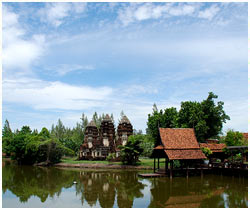Attractions
Statue of King Narai
The idol commemorates King Narai who made Lop Buri an important and prosperous town. King Narai was the first Thai monarch who established diplomatic relations with France. He constructed several other important structures in Lob Buri.
Phra Prang Sam Yot
This is Lopburi's best known landmark. The laterite and sandstone structure have been built in the Lop Buri style and bedecked with stucco.
Prang Khaek
This Khmer ruin was built in the 15th century as a Hindu shrine with three nearby towers. This is the oldest monument in Lop Buri.
 Wat Sao Thong Thong
Wat Sao Thong ThongThe wihara and the main Buddha image in Wat Sao Thong Thong were created in the Ayutthaya period. King Narai gave western look to the windows of the wihara.
Lop Buri Zoo
25-acre Lop Buri Zoo has Asian and Australian birds and mammals. You could find tigers and dogs living in complete harmony here.
Wat Yang Na Rangsi
This temple has four Buddha images made of sandstone and quartz. Built in Lawo period, the temple offers typical style of the rural central region. It has been transformed into a local boat museum displaying now a collection of local boats and oars.
Location
Lopburi is located 153 kilometres north of Bangkok. The place covers an area of 6,199 square kilometres.
How to Reach
Car is the most convenient way to reach Lop Buri from Bangkok. Buses for Lopburi are available from Northern Bus Terminal. Trains for Lop Buri leave from Hua Lamphong railway station.



